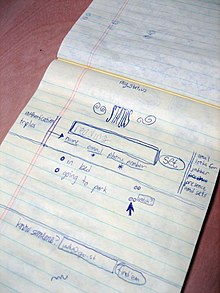Sketchnotes
Sketchnotes are notes that consist of text, images and structures. The term is composed of sketch ( English sketch ' sketch ' ) and note ( English note ' note ' from Latin notitia 'knowledge, message' ).
The creation of sketch notes is called "sketchnoting" or "visual note taking". Sketchnotes are often made as an alternative to conventional transcripts. In contrast to texts, sketch notes are rarely structured linearly. The hierarchy of the content is determined by the type of visualization. It can follow a path, be in the form of rays ( mind map-like ) or rather wildly distributed on the leaf ("Popcorn" according to Mike Rohe).
purpose
Sketchnotes fulfill the task of making the content more understandable. They should help to be able to remember the transmitted information better, using the mnemonic mental factors . Similar to a scribble , sketch notes can also be used to develop new content and ideas. They also serve for reflection, networking with your own prior knowledge and practicing visualization techniques. Sketchnotes facilitate an exchange on the respective topic.
origin

The principle of sketch notes is ancient. A generous interpretation of the term could also include cave paintings or drawings by Leonardo Da Vinci , such as B. call fetus in uterus or Orbis sensualium pictus as a sketch note. Thanks to the design of interfaces in the IT area, the level of awareness of sketching has increased again and has established itself as a term, for example in the development of Twitter .
The design of your own lesson records, e.g. B. in the college block , often consists of factual texts and graphics. In addition, they are often painted over with doodles, which are usually an expression of boredom and the content is hardly related to the topic. Sketchnotes are intended to encourage the creators to channel their visual expressiveness in such a way that the painting does not remove content, but rather creates an intensified examination of it.
Creation
Ballpoint pens, markers or pencils on paper are usually used to create sketch notes. In the meantime, however, sketchnotes are also often created on tablet computers because there is no limit to the number of paper, colors and pen variants available. In addition, the results are available directly in digital form and can thus be easily distributed. At conferences, these sketch notes are often distributed via Twitter or blogs by adding the appropriate tags or hashtags . Sketchnotes consist of simple drawings, symbols and graphic elements. Another part of the sketchnotes is often hand lettering. These are unusual lettering (words, quotes or sayings) that can be added as well. Hand lettering is an offshoot of calligraphy and can be defined as "the art of drawing letters" - as opposed to simply writing letters.
Literature on the subject
- Eva-Lotta Lamm: Sketchnotes 2009/2010 . CreateSpace Independent Publishing Platform, 2011, ISBN 978-1-4775-4675-8 .
- Dan Roam: The Back of the Napkin: Solving Problems and Selling Ideas with Pictures . Marshall Cavendish International (Asia) Pte Ltd, 2012, ISBN 978-981-4382-24-3 .
- Mike Rohde: The Sketchnote Handbook: the illustrated guide to visual note taking . 1st edition. Peachpit Press, 2012, ISBN 978-0-321-85789-7 .
- Ines Schaffranek: Everyone can do sketchnotes: Visual notes made easy . Rheinwerk Verlag, 2017, ISBN 978-3-8362-4337-7 .
- Nadine Roßa: Sketchnotes - visual notes for everything: from business meetings to party planning to recipes. Frechverlag, Stuttgart 2017, ISBN 978-3-7724-8240-3 .
- Nadine Roßa: Sketchnotes - The Great Symbol Library , Frechverlag, Stuttgart 2020, ISBN 978-3-7724-8389-9 .
- Nadine Roßa: Sketchnotes - Der Quick-Start-Block , Frechverlag, Stuttgart 2019, ISBN 978-3-7724-8358-5
Individual evidence
- ↑ Visual thinking with sketch notes - an anchor in your head. In: sketchnotes.de. Retrieved October 17, 2016 .
- ↑ Nadine Roßa: Bringing structure into sketch notes ! This is how it works - Part 1. Accessed on July 19, 2020 (German).
- ^ Nicolai Marquardt, Saul Greenberg: Sketchnotes for Visual Thinking in HCI . Proc. ACM Conference on Human Factors in Computing Systems: CHI Workshop on Visual Thinking and Digital Imagery. (Workshop held at the ACM CHI Conference). Austin, Texas, USA May 5, 2012 (English, ucalgary.ca [PDF; 1.4 MB ]).
- ↑ Catriona Cornett: 50 Sketching Resources for User Experience Designers. In: inspireUX. Retrieved October 17, 2016 .
- ↑ Hand lettering as part of sketch noting. Retrieved May 10, 2017 .
- ↑ Tanja Cappell: Hand lettering alphabets: step by step to your own calligraphy . 4th edition. Edition Michael Fischer, Igling 2017, ISBN 978-3-86355-768-3 .
